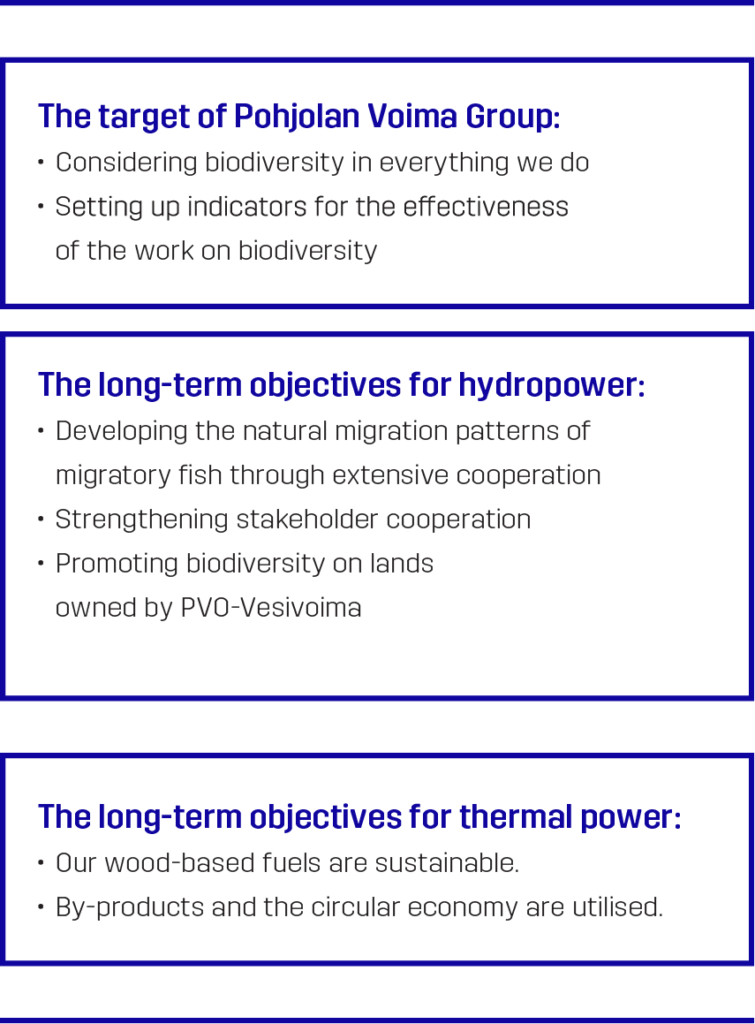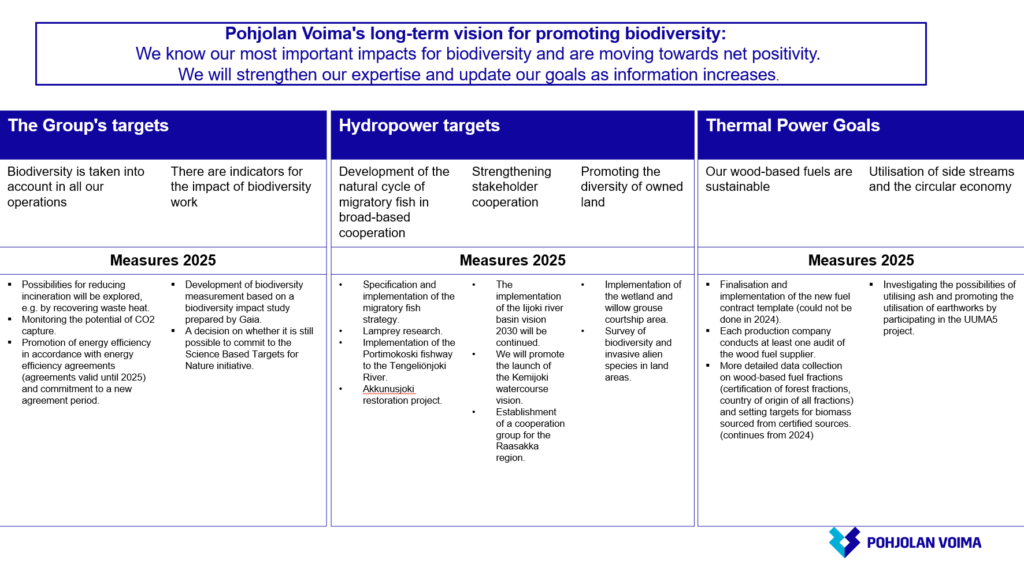Biodiversity
Alongside climate change, the loss of biodiversity is the biggest threat to the planet. In 2022, we surveyed how our operations have affected biodiversity, and how we can play our part in halting the loss of biodiversity. We prepared an action plan for 2023−2027 based on the survey results, focusing on hydropower and thermal power. In terms of nuclear power, the work on biodiversity is carried out by our joint venture Teollisuuden Voima.
Biodiversity is included in our strategy. As a responsible company, we reconcile competitive carbon neutral production with biodiversity. We want to produce hydropower responsibly and use sustainably produced wood-based fuels in CHP.
Our biodiversity vision
Our long-term biodiversity vision is to identify our key impact on biodiversity and move towards net positivity. We will promote our skill set and update our target as knowledge increases.
We have set long-term goals to achieve our vision:

Biodiversity action plan for 2025

In 2024, we achived 80% of the measures planned for enhancing biodiversity. The implementation of the unfinished measures will continue in 2025. One of the key targets is to develop the metrics for the impacts of the biodiversity efforts.
In hydropower, we continued our collaboration in migratory fish projects
In 2024, we continued cooperation to benefit migratory fish and the aquatic environment in our operating areas.
- Finland’s first downstream migration route for salmon fry, including catching equipment, was introduced at Haapakoski on the Iijoki river in the summer of 2022. The route is developed further and its operation is studied.
- In 2024–2026, the Lohi Iijokeen 2 (Salmon to Iijoki 2) is a a continuation of the extensive cooperation of the previous projects, Lohi Iijokeen 2022–2024 and Iijoen vaelluskalahanke 2020–2022 (Iijoki river migratory fish project). The measures include, among other things, planting fry and producing information on the functionality of the Haapakoski downstream migration route.
- The Iijoki agreement for 2024–2028 is implementing the Iijoki waterway vision 2030 by restoring drained swamps and improving water quality in the Iijoki river catchment area, for example. The agreement is continued from a previous agreement period of 2019–2023.
- The development of the approximately 9 km long old Raasakka riverbed as a natural breeding area for migratory fish continued by the pumping of additional water into the riverbed throughout the summer season.
- The cooperation of a modelling project of the Iijoki old riverbed at Raasakka aims to explore the possibilities of developing the old riverbed into a migratory fish nursery area and migratory fish route. A working group to monitor the work has been established.
- A hydraulic fishway, Fishheart, has been installed at Raasakka, the lowermost power plant in the Iijoki river, for the 2023–2025 period. The functionality of Fishheart is actively developed and improved in cooperation with the supplier.
- With Fishheart and the downstream migration route at the Haapakoski rapids, an assisted natural cycle of migratory fish has been started in the Iijoki river. Fish that pass through Fishheart are moved to nursery areas above Haapakoski. The passage of smolts aiming for the sea arriving at the Haapakoski downstream migration route is monitored, and fish are moved downstream below Raasakka. By researching and developing the impacts, it is possible to obtain valuable research data and more information for next by-pass routes.
- Two fishways will be built at the Portimokoski power plant of our asscociated company Tornionlaakson Voima. Located in Tengeliönjoki river, they will open up a breeding area of 1,000 km for migratory fish. The first one, a natural fisway was completed in autumn of 2024, and the second will be built during 2025.
- We also participate in joint projects to restore migratory fish stocks in the Kemijoki and Ounasjoki rivers.
- Recommended water level regulation ranges have been prepared for the regulation of Suolijärvi Lakes in the Jumiskonjoki river and lake system in cooperation with the authorities and residents.
We use sustainable wood-based fuels
Pohjolan Voima’s combined heat and power plants use wood-based fuels as their main fuels. The wood-based fuels used meet the sustainability criteria of the Renewable Energy Directive (RED II, sustainability of biomass).
We develop sustainable procurement of wood-based fuels. Our goal is to specify our sustainability criteria related to wood-based fuels and to take the criteria into consideration in our fuel procurement agreements. We will also survey the significance of certification in relation to biodiversity. We will find out the share of our wood-based fuels that come from certified sources and evaluate what kind of targets we can set for certification.